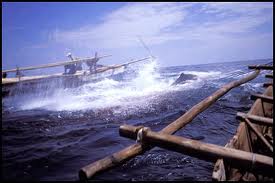Explore the Extraordinary: Whale trips

Around the world, the village of Lamalera on the island of Lembata on Flores is known as the home of traditional whale hunting. Portuguese documents dating back to 1643 already mention that these heroic hunts were sighted then.
In Lamalera, villagers hunt large sea animals, like whales and manta rays to provide food and a living for the entire village, which they undertake on simple sailboats and following ancient beliefs, taboos and tradition.
It is for these reasons that the Lamalera whale hunts are until this day exempt from the international ban on whaling, considering the traditional way this is still done and the fact that hunting these giant ocean creatures help villagers support their subsistence economy.
Annually, whales migrate between the Indian Ocean and the Pacific during May through October, when these giant sea animals pass the Savu Sea right at the doorstep of the island of Lembata. For Lembata, therefore, whale hunting starts on 1 May reaching its peak in July.
The Whale Hunting Ritual
In 1996, Oxford University researcher, R.H. Barnes wrote the “Sea Hunters of Indonesia: Fishers and Weavers of Lamalera”, describing this communal hunt for sperm whales (Physeter macrocepalus) by the villagers in Lamalera, on Lembata Island.
The village of Lamalera is surrounded by rocky hills and barren land, facing the wild sea of Savu.
When whaling season arrives, the boats are released. Crowds cheer as more boats, locally called peledang, glide out from the najeng, the boat houses. Tale leo, the rope made out of local vegetation, is hoisted to raise the sail. Another tale leo is fastened to the spiky harpoon. The whale hunt can take hours, and in some instances, it can take lives. The villagers catch only sperm whales as the tradition holds. Blue whales (Balaenoptera musculus) occasionally pass by the surrounding waters. However, these villagers would lead the approaching blue whales to the open sea and give them a warm good bye. Blue whales are considered taboo to hunt as they are believed to be the keepers of the Lamalera. They consider the blue whale as their mother, and hunting them is thus a sin.
When a whale approaches, the lamafa, the harpoonist jumps off the boat and stabs the cetaceans with a tempuling, a handmade harpoon. The heart-stopping action of a lamafa is one of the anticipated moments in the world of visual documentation. The curious visitors would wait for days to come along with the groups of matros, boatmen led by a lamafa. They would stay with the fishermen and the families to understand the fishermen’s unique lives. Baleo! Baleo! The villagers shout out as the awaited whale surfaces in the distance.

There are more taboos for the Lamaleras when it comes to whale hunting. It is also forbidden to hunt pregnant whales, young whales, and mating whales. This capacity to recognize these specific taboos can only be learnt through extensive periods of experience. Unfortunately, some elders worry that the tradition is vanishing as youngsters tend to separate tradition from convenient modernity, so that future generations will no longer adhere to such precious traditional values.
In response to the impending threat of disappearance, elders of Lamalera have transformed the seasonal practice into a festival called the Baleo Festival, which was started in 2009 and held annually until now. During the festival, traditional costumes are donned, and those who were born and raised in Lamalera congregate to make the festival not just a success, but also a legacy for the descendants of Lamalera. The message of the ancestors must be passed down, which is to keep the tradition and local wisdom alive.
Prior to the kotoklema hunt, a lefa, a ritual led by the village elder or a church priest, is held to invite the anticipated whales. One boat can accommodate 7 to 12 matros, led by a lamafa or also called balafaing. When a lamafa springs into the water and thrusts the harpoon to the heart of the sea giant, the matros must be ready to handle the potential danger caused by the injured whale, which will often swim under and drag the boat with it. Three to four stabs are needed to paralyze the targeted whale, so the boat can tow the catch back to the village, and share it with the rest of the people ashore.
This unique trip can be experienced with Agusto Rumat as your trusted guide and of course just in the season: May - July. See the unspoiled Eastern part of Indonesia and encounter a way of living that goes back for ages.
Lamalere Hunting Whale: 5d/4n
Day 1: Maumere-Lamalera village
Day 2: Lamalera hunting whale
Day 3: Lamalera-Lewoleba-Ile Ape
Day 4: Lewoleba-Larantuka
Day 5: Larantuka-Maumere
Due to the special character of this trip at least 2 persons should join. Price: Rp. 5.150.000 per person.
Tip
If you are not into gory scenes, this hunt can be very disturbing. You may want to stay ashore. When you decide to go along in a boat led by a lamafa, you should be ready with all the risks, as the raging whale can be very deadly. Beware of the frenzy as you may lose your equipment, especially your cameras.
